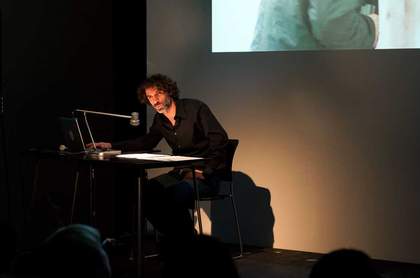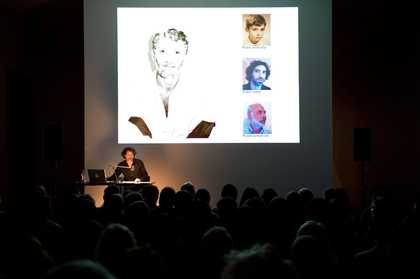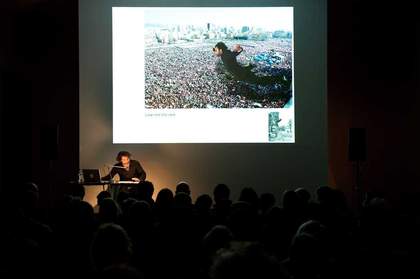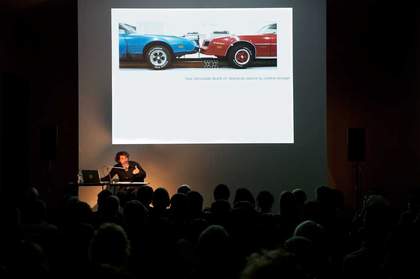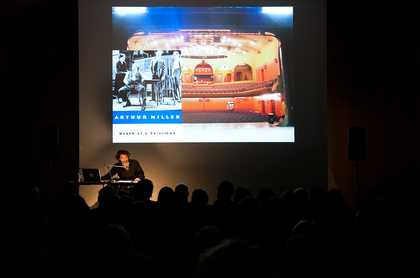Theater with dirty feet – a talk on theater into art was a performance-lecture by the Lebanese artist Rabih Mroué. For an hour Mroué sat at a table facing the audience, illuminated by a lamp that also made visible his notes. Still images of his previous work and historical works that had influenced them were projected onto the wall behind him as he described and discussed them. He also projected – and read aloud – correspondence between himself and different interlocutors, making visible a back-and-forth dialogue around his works and the exhibitions in which they featured.
Mroué was trained in theatre, has worked as an actor and has explored theatrical conventions in his art works. He used this performance to pose the questions: can Rabih Mroué be considered a visual artist and what does this mean?1 This simple question opened up a debate concerning the relationship between disciplinary fields and particularly the definition of art against the theatrical in Western modern art discourse.
Mroué presented and discussed his photomontage Leap into the void 2006, which was shown in dialogue with the iconic original piece, Yves Klein’s Leap into the Void 1960. While in the famous doctored photograph Klein appears to leap into an almost empty street, in Mroué’s version the image of the leaping was pasted over one of a crowd of demonstrators in Beirut. Mroué resituated Klein’s act in Lebanon at a moment of political unrest, bringing the tension between the apparent action and the image to a new context. Mroué’s citation of Klein highlighted the complex relationship between truth and fiction at the intersection of performance and art. This moment in the performance-lecture also situated him within a larger art historical narrative of performance at the intersection of theatre, photography, image manipulation and artistic identity. It emphasised the cross-disciplinary nature of performance not only in Mroué’s work but also as part of its intrinsic character.
Mroué traced his practice across theatrical works to installations and manipulated photography, exploring the intersections between the two fields, which he earlier described as distinct. The juxtaposition of Mroué’s own practice with other artworks that fall between visual art and theatre – such as Chris Burden’s Trans-fixed 1974 and The Slow Inevitable Death of American Muscle 2007 by Jonathan Schipper – allowed him to sketch out a broad historical argument while seemingly only talking about his own work and practice.
Mroué’s lecture was presented in a deliberately ambiguous manner, leaving the audience to consider whether they were watching an artist’s talk or a performance. Mroué ended the lecture by suggesting that those present would be the ones who could determine whether or not what they had witnessed was ‘art’. Over the course of the hour Mroué defended what he felt was the most important element of any artistic work – the act of discussion. The performance enacted this process of talking about art, with the artist’s own work, ending by claiming that discussion – rather than art’s material constituents – became the process through which an artwork could be defined.
Theater with dirty feet – a talk on theater into art was part of Tate Modern Live: Push and Pull (18–19 March 2011). Push and Pull was an event based around the American artist Allan Kaprow’s performance environment, Push and Pull: A Furniture Comedy for Hans Hoffman 1963. In this work Kaprow reinterpreted the phrase ‘push and pull’ from Hans Hoffman’s instruction for creating a sense of movement in painting, into a means of creating movement in performance and therefore transposing theory from the flat canvas into a living, social space. The performances presented as part of Push and Pull incorporated elements of traditional genres, such as sculpture, painting and photography, to explore performance as a hybrid medium with the potential to explore complex, boundary-crossing issues, theories and concepts.
Acatia Finbow
October 2015

